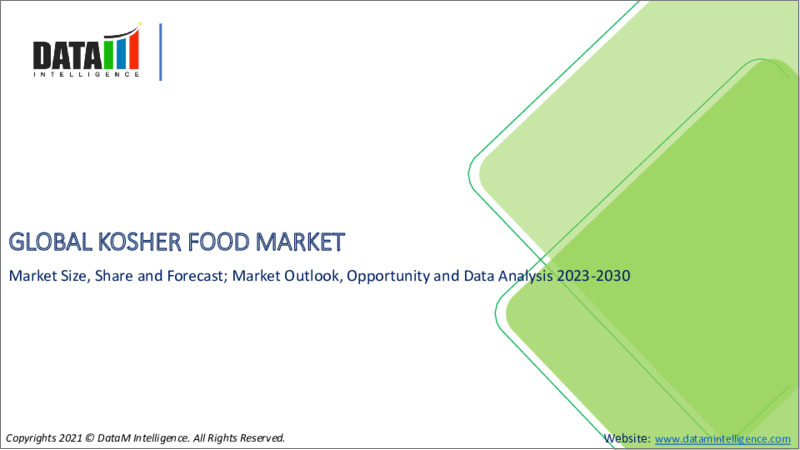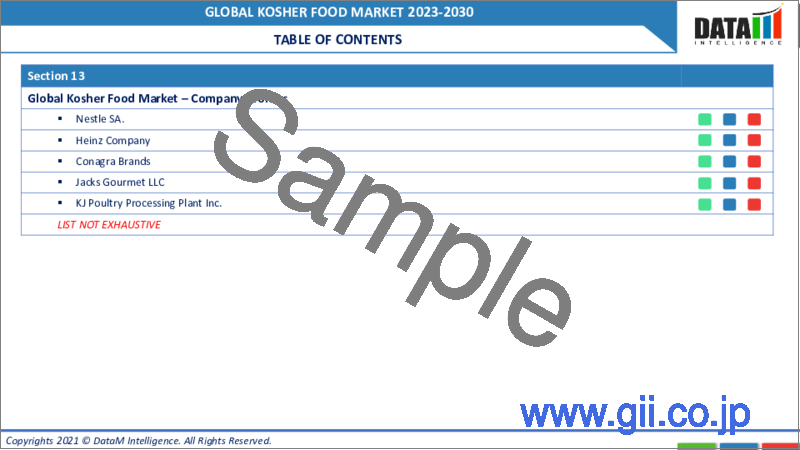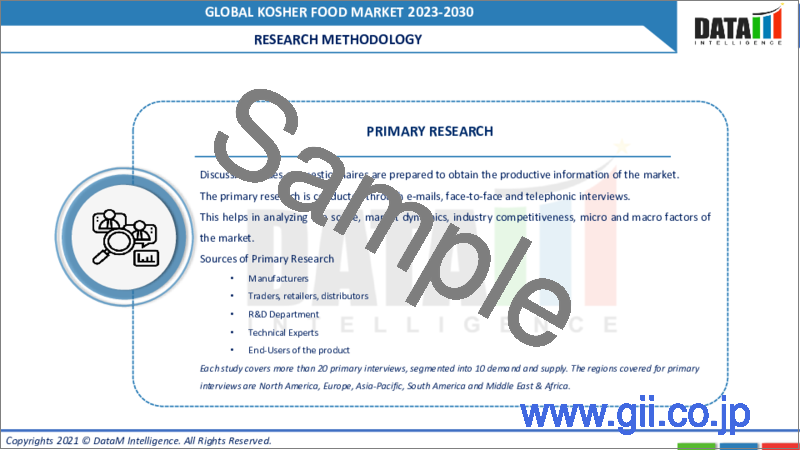|
|
市場調査レポート
商品コード
1279686
コーシャフードの世界市場-2023-2030Global Kosher Food Market - 2023-2030 |
||||||
|
● お客様のご希望に応じて、既存データの加工や未掲載情報(例:国別セグメント)の追加などの対応が可能です。 詳細はお問い合わせください。 |
|||||||
| コーシャフードの世界市場-2023-2030 |
|
出版日: 2023年05月26日
発行: DataM Intelligence
ページ情報: 英文 123 Pages
納期: 約2営業日
|
- 全表示
- 概要
- 目次
市場概要
コーシャフードの世界市場は、2022年に204億5,620万米ドルに達し、2030年には最大282億1,180万米ドルに達することで有利な成長が予測されます。同市場は、予測期間2023年から2030年の間、CAGR4.1%で成長しています。
世界のコーシャフード市場は、ユダヤ教徒および非ユダヤ教徒の消費者の間でコーシャー認証製品への需要が高まっている成長産業です。市場は大企業と中小企業が混在しており、非常に細分化されています。市場を形成する主な動向としては、主要な食料品店でのコーシャー認証製品の入手可能性、植物由来およびビーガンのコーシャフードの人気、新しいコーシャフード認証機関の出現などが挙げられます。
市場力学
消費者の高品質で安全な食品に対する需要の高まりが市場成長を促進
世界のコーシャフード市場は、様々な要因によって、今後数年間は安定的に成長すると予想されます。主な要因は、特にユダヤ人の人口が多い地域で、消費者の間で高品質で安全な食品への需要が高まっていることです。コーシャフードは、厳格な食事に関する法律を遵守し、厳格な監督と認証プロセスを経ているため、これらの基準を満たしていると認識されており、これが市場成長を促進する要因となっています。
コーシャフードの生産と認証の拡大が市場需要を促進する
ユダヤ人人口は比較的少ないもの、コーシャフードへの関心が高いアジアや欧州を中心に、さまざまな地域でコーシャフードの生産と認証が拡大しています。コーシャフードの製造・販売業者にとって、新たな市場を開拓し、売上と利益を増大させる機会を生み出しています。
COVID-19の影響分析
COVID-19の大流行は、世界のコーシャフード市場に大きな影響を与えました。コーシャ認証製品の需要は比較的安定しているもの、パンデミックによってサプライチェーンが混乱し、一部のコーシャフードに欠品や値上げが発生しました。しかし、健康志向の高い消費者のコーシャフードに対する意識の高まり、自然食品や有機食品に対する需要の高まり、オンラインショップやスーパーマーケットなどの流通経路の拡大などが、市場の拡大につながり、需要は継続すると思われます。
ウクライナ・ロシア戦争影響分析
ウクライナ・ロシア戦争は、貿易やサプライチェーンを混乱させ、一部のコーシャフードの品薄や価格上昇を引き起こしています。ウクライナとロシアはともに肉や乳製品などのコーシャフードの主要生産国であり、紛争によってこれらの製品の生産と流通が阻害されています。
また、紛争はユダヤ人消費者に心理的な影響を与え、紛争地域で生産されたコーシャフードの摂取をためらう可能性があります。そのため、北米やイスラエルなど、他の地域で生産されたコーシャ認証製品に需要がシフトしています。
人工知能の影響分析
人工知能(AI)は、消費者データを分析し、動向や嗜好を特定するために使用することができ、食品会社は新しいコーシャ認証製品を開発することができ、彼らは製品の加工方法にそれを使用しています。それは変化する消費者のニーズや好みに合わせて。
さらに、AIを活用したマーケティングと販売戦略により、食品会社はコーシャフードの消費者をより的確に絞り込んで取り込み、需要を喚起して市場シェアを拡大することができます。
目次
第1章 調査手法とスコープ
- 調査手法
- 調査目的および調査範囲
第2章 定義と概要
第3章 エグゼクティブサマリー
- 食品ソース別
- 食品別
- アプリケーション別
- 地域別
第4章 市場力学
- 影響要因
- 促進要因
- 抑制要因
- 機会
- 影響分析
第5章 産業分析
- ポーターのファイブフォース分析
- サプライチェーン分析
- 価格分析
- 法規制の分析
第6章 COVID-19の分析
- COVID-19の分析
- COVID-19登場前シナリオ
- 現在のCOVID-19シナリオ
- COVID-19後または将来のシナリオ
- COVID-19の中での価格・ダイナミクス
- 需給スペクトル
- パンデミック時の市場に関連する政府の取り組み
- メーカー各社の戦略的取り組み
- サマリー
第7章 食品ソース別
- 肉類
- 乳製品
- パレブ
第8章 食品別
- 海産物
- 肉・鶏肉加工品
- 飲料
- 主食
- スナック&セイボリー
- ベーカリー・菓子類
- その他
第9章 流通チャネル別
- スーパーマーケット/ハイパーマーケット
- コンビニエンスストア
- オンライン販売
- その他
第10章 地域別
- 北米
- 米国
- カナダ
- メキシコ
- 欧州
- ドイツ
- 英国
- フランス
- イタリア
- スペイン
- その他欧州
- 南米
- ブラジル
- アルゼンチン
- その他南米地域
- アジア太平洋地域
- 中国
- インド
- 日本
- オーストラリア
- その他アジア太平洋地域
- 中東・アフリカ地域
第11章 競合情勢
- 競合シナリオ
- 市況ポジショニング/シェア分析
- M&A(合併・買収)分析
第12章 企業プロファイル
- Cargill Corp.
- 会社概要
- 製品ポートフォリオと説明
- 財務概要
- 主な発展状況
- General Mills Inc.
- Empire Kosher Poultry, LLC
- Conagra Foodservice, Inc.
- Dean Foods
- Nectar Lifesciences Ltd.
- Bob's Red Mill Natural Foods
- Nestle SA
- Archer Daniels Midland Company
- The Hain Celestial Group
第13章 付録
Market Overview
The Global Kosher Food Market reached US$ 20,456.2 million in 2022 and is projected to witness lucrative growth by reaching up to US$ 28,211.8 million by 2030. The market is growing at a CAGR of 4.1% during the forecast period 2023-2030.
The global kosher food market is a growing industry with increasing demand for kosher-certified products among Jewish and non-Jewish consumers. The market is highly fragmented with a mix of large and small players. The key trends shaping the market include the availability of kosher-certified products in mainstream grocery stores, the popularity of plant-based and vegan kosher food products, and the emergence of new kosher food certification agencies.
Market Dynamics
Increasing Demand for High-quality and Safe Food Products Among Consumers Drives the Market Growth
The global kosher food market is expected to grow steadily in the coming years, driven by various factors. The main driver is the increasing demand for high-quality and safe food products among consumers, especially in regions with large Jewish populations. Kosher food products are perceived as meeting these criteria, as they adhere to strict dietary laws and undergo rigorous supervision and certification processes, which are factors driving the market growth.
Increasing Expansion of Kosher Food Production and Certification Drives the Market Demand
The expansion of kosher food production and certification in various regions, especially in Asia and Europe, where the Jewish population is relatively small but the interest in kosher food is high. It creates opportunities for kosher food manufacturers and distributors to tap into new markets and increase their sales and profits.
COVID-19 Impact Analysis
The COVID-19 pandemic has had a significant impact on the global Kosher food market. While the demand for Kosher-certified products has remained relatively stable, the pandemic has disrupted supply chains, causing shortages and price increases for some Kosher food products. However, increased awareness of kosher food among health-conscious consumers, the risen demand for natural and organic food products and the expansion of distribution channels such as online stores and supermarkets, which are led to the market expansion to continue the demand.
Ukraine-Russia War Impact Analysis
The Ukraine-Russia war has disrupted trade and supply chains, causing shortages and price increases for some kosher food products. Ukraine and Russia are both major producers of kosher food products, including meat and dairy products, and the conflict has disrupted the production and distribution of these products.
The conflict has also had a psychological impact on Jewish consumers, who may be hesitant to consume kosher food products produced in areas affected by the conflict. This has led to a shift in demand towards kosher-certified products produced in other regions, such as North America and Israel
Artificial Intelligence Impact Analysis
Artificial Intelligence (AI) can be used to analyze consumer data and identify trends and preferences, allowing food companies to develop new kosher-certified products and they are using it in product processing methods. that meet changing consumer needs and preferences.
Additionally, AI-powered marketing and sales strategies can help food companies better target and engage with kosher food consumers, driving demand and increasing market share.
Segment Analysis
The global kosher food market is segmented based on the food source, food product, distribution channel, and region.
Increased Use of Fertigation Methods by the Farmers
The seafood segment holds the largest share of the kosher food market in 2022. This is driven by the high demand for Kosher-certified seafood products among Jewish and non-Jewish consumers alike, who value the health benefits and sustainability of seafood. The popularity of Kosher seafood products has encouraged food companies to invest in kosher certification and expand their product lines and has driven market growth.
Geographical Analysis
Increased Innovations and Investments of Major Companies
The North American region accounted for the largest share of the market revenue, followed by Europe and Asia-Pacific. This region's highly developed food industry infrastructure and distribution networks have allowed food companies to efficiently produce and distribute Kosher-certified products to consumers.
The popularity of Kosher food products in North America has also led to the availability of Kosher-certified products in mainstream grocery stores, making them more accessible to non-Jewish consumers, which are factors that led to the dominance of the global kosher food market.
Competitive Landscape
The major global kosher food market players include: Cargill Corp., General Mills Inc., Empire Kosher Poultry, LLC, Conagra Foodservice, Inc., Dean Foods, Nectar Lifesciences Ltd., Bob's Red Mill Natural Foods, Nestle SA, Archer Daniels Midland Company and The Hain Celestial Group.
Why Purchase the Report?
- To visualize the global kosher food market segmentation based on the food source, food product, distribution channel and region, as well as understand key commercial assets and players.
- Identify commercial opportunities by analyzing trends and co-development.
- Excel data sheet with numerous data points of kosher food market-level with all segments.
- PDF report consists of a comprehensive analysis after exhaustive qualitative interviews and an in-depth study.
- Product mapping available as Excel consisting of key products of all the major players.
The Global Kosher Food Market Report Would Provide Approximately 61 Tables, 62 Figures and 123 Pages.
Target Audience 2023
- Manufacturers / Buyers
- Industry Investors/Investment Bankers
- Research Professionals
- Emerging Companies
Table of Contents
1. Methodology and Scope
- 1.1. Research Methodology
- 1.2. Research Objective and Scope of the Report
2. Definition and Overview
3. Executive Summary
- 3.1. Snippet by Food Source
- 3.2. Snippet by Food Product
- 3.3. Snippet by Application
- 3.4. Snippet by Region
4. Dynamics
- 4.1. Impacting Factors
- 4.1.1. Drivers
- 4.1.2. Restraints
- 4.1.3. Opportunity
- 4.1.4. Impact Analysis
5. Industry Analysis
- 5.1. Porter's Five Forces Analysis
- 5.2. Supply Chain Analysis
- 5.3. Pricing Analysis
- 5.4. Regulatory Analysis
6. COVID-19 Analysis
- 6.1. Analysis of COVID-19
- 6.1.1. Before COVID-19 Scenario
- 6.1.2. Present COVID-19 Scenario
- 6.1.3. Post COVID-19 or Future Scenario
- 6.2. Pricing Dynamics Amid COVID-19
- 6.3. Demand-Supply Spectrum
- 6.4. Government Initiatives Related to the Market During the Pandemic
- 6.5. Manufacturers' Strategic Initiatives
- 6.6. Conclusion
7. By Food Source
- 7.1. Introduction
- 7.1.1. Market Size Analysis and Y-o-Y Growth Analysis (%), By Food Source
- 7.1.2. Market Attractiveness Index, By Food Source
- 7.2. Meat*
- 7.2.1. Introduction
- 7.2.2. Market Size Analysis and Y-o-Y Growth Analysis (%)
- 7.3. Dairy
- 7.4. Pareve
8. By Food Product
- 8.1. Introduction
- 8.1.1. Market Size Analysis and Y-o-Y Growth Analysis (%), By Food Product
- 8.1.2. Market Attractiveness Index, By Food Product
- 8.2. Sea Food*
- 8.2.1. Introduction
- 8.2.2. Market Size Analysis and Y-o-Y Growth Analysis (%)
- 8.3. Processed Meat and Poultry
- 8.4. Beverages
- 8.5. Staples
- 8.6. Snacks and Savory
- 8.7. Bakery and Confectionery
- 8.8. Others
9. By Distribution Channel
- 9.1. Introduction
- 9.1.1. Market Size Analysis and Y-o-Y Growth Analysis (%), By Distribution Channel
- 9.1.2. Market Attractiveness Index, By Distribution Channel
- 9.2. Supermarkets/Hypermarkets*
- 9.2.1. Introduction
- 9.2.2. Market Size Analysis and Y-o-Y Growth Analysis (%)
- 9.3. Convenience Stores
- 9.4. Online Sales
- 9.5. Others
10. By Region
- 10.1. Introduction
- 10.1.1. Market Size Analysis and Y-o-Y Growth Analysis (%), By Region
- 10.1.2. Market Attractiveness Index, By Region
- 10.2. North America
- 10.2.1. Introduction
- 10.2.2. Key Region-Specific Dynamics
- 10.2.3. Market Size Analysis and Y-o-Y Growth Analysis (%), By Food Source
- 10.2.4. Market Size Analysis and Y-o-Y Growth Analysis (%), By Food Product
- 10.2.5. Market Size Analysis and Y-o-Y Growth Analysis (%), By Distribution Channel
- 10.2.6. Market Size Analysis and Y-o-Y Growth Analysis (%), By Country
- 10.2.6.1. The U.S.
- 10.2.6.2. Canada
- 10.2.6.3. Mexico
- 10.3. Europe
- 10.3.1. Introduction
- 10.3.2. Key Region-Specific Dynamics
- 10.3.3. Market Size Analysis and Y-o-Y Growth Analysis (%), By Food Source
- 10.3.4. Market Size Analysis and Y-o-Y Growth Analysis (%), By Food Product
- 10.3.5. Market Size Analysis and Y-o-Y Growth Analysis (%), By Distribution Channel
- 10.3.6. Market Size Analysis and Y-o-Y Growth Analysis (%), By Country
- 10.3.6.1. Germany
- 10.3.6.2. The UK
- 10.3.6.3. France
- 10.3.6.4. Italy
- 10.3.6.5. Spain
- 10.3.6.6. Rest of Europe
- 10.4. South America
- 10.4.1. Introduction
- 10.4.2. Key Region-Specific Dynamics
- 10.4.3. Market Size Analysis and Y-o-Y Growth Analysis (%), By Food Source
- 10.4.4. Market Size Analysis and Y-o-Y Growth Analysis (%), By Food Product
- 10.4.5. Market Size Analysis and Y-o-Y Growth Analysis (%), By Distribution Channel
- 10.4.6. Market Size Analysis and Y-o-Y Growth Analysis (%), By Country
- 10.4.6.1. Brazil
- 10.4.6.2. Argentina
- 10.4.6.3. Rest of South America
- 10.5. Asia-Pacific
- 10.5.1. Introduction
- 10.5.2. Key Region-Specific Dynamics
- 10.5.3. Market Size Analysis and Y-o-Y Growth Analysis (%), By Food Source
- 10.5.4. Market Size Analysis and Y-o-Y Growth Analysis (%), By Food Product
- 10.5.5. Market Size Analysis and Y-o-Y Growth Analysis (%), By Distribution Channel
- 10.5.6. Market Size Analysis and Y-o-Y Growth Analysis (%), By Country
- 10.5.6.1. China
- 10.5.6.2. India
- 10.5.6.3. Japan
- 10.5.6.4. Australia
- 10.5.6.5. Rest of Asia-Pacific
- 10.6. Middle East and Africa
- 10.6.1. Introduction
- 10.6.2. Key Region-Specific Dynamics
- 10.6.3. Market Size Analysis and Y-o-Y Growth Analysis (%), By Food Source
- 10.6.4. Market Size Analysis and Y-o-Y Growth Analysis (%), By Food Product
- 10.6.5. Market Size Analysis and Y-o-Y Growth Analysis (%), By Distribution Channel
11. Competitive Landscape
- 11.1. Competitive Scenario
- 11.2. Market Positioning/Share Analysis
- 11.3. Mergers and Acquisitions Analysis
12. Company Profiles
- 12.1. Cargill Corp.*
- 12.1.1. Company Overview
- 12.1.2. Product Portfolio and Description
- 12.1.3. Financial Overview
- 12.1.4. Key Developments
- 12.2. General Mills Inc.
- 12.3. Empire Kosher Poultry, LLC
- 12.4. Conagra Foodservice, Inc.
- 12.5. Dean Foods
- 12.6. Nectar Lifesciences Ltd.
- 12.7. Bob's Red Mill Natural Foods
- 12.8. Nestle SA
- 12.9. Archer Daniels Midland Company
- 12.10. The Hain Celestial Group
LIST NOT EXHAUSTIVE
13. Appendix
- 13.1. About Us and Services
- 13.2. Contact Us




